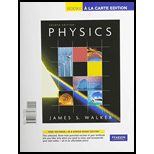
Concept explainers
How many grams of the following nonelectrolytes would have to be mixed with 100.0 g of p-dichlorobenzene to increase the boiling point by 3.0°C? To decrease the freezing point by 2.0°C? (Use Table 10.2.)
(a) succinic acid (C4H6O4)
(b) caffeine (C8H10N4O2)
(a)
Interpretation:
The mass of succinic acid mixed with 100.0 g of p-dichlorobenzene to increase the boiling point by
Concept introduction:
Non-electrolytes are substances which do not dissociate into ions in the aqueous solution. Thus, they do not conduct electricity.
If a non−volatile solute is added to a volatile solvent, elevation in freezing point takes place. This can be determined using the following formula:
Here,
Similarly, the depression in freezing point can be calculated as follows:
Here,
And,
Molality is defined as number of moles of solute in 1 kg of the solvent.
Answer to Problem 40QAP
The mass of succinic acid mixed with 100.0 g of p-dichlorobenzene to increase the boiling point by
Explanation of Solution
The elevation in boiling point can be calculated using the following formula:
Here,
Since,
So,
Thus, to increase the boiling point by
Now, molality is related to number of moles of solute as follows:
Put the values of mass solvent as
To calculate the freezing point depression, following formula is used.
Here
Since,
So,
To decrease the freezing point by
Now,
Put the values of mass solvent as
Since, molar mass of succinic acid
For boiling point case:
For freezing point case:
(b)
Interpretation:
The mass of caffeine mixed with 100.0 g of p-dichlorobenzene to increase the boiling point by
Concept introduction:
Non-electrolytes are substances which do not dissociate into ions in the aqueous solution. Thus, they do not conduct electricity.
If a non−volatile solute is added to a volatile solvent, elevation in freezing point takes place. This can be determined using the following formula:
Here,
Similarly, the depression in freezing point can be calculated as follows:
Here,
And,
Molality is defined as number of moles of solute in 1 kg of the solvent.
Answer to Problem 40QAP
The mass of caffeine mixed with 100.0 g of p-dichlorobenzene to increase the boiling point by
Explanation of Solution
The elevation in boiling point can be calculated using the following formula:
Here,
Since,
So,
Thus, to increase the boiling point by
Now, molality is related to number of moles of solute as follows:
Put the values of mass solvent as
To calculate the freezing point depression, following formula is used.
Here
Since,
So,
To decrease the freezing point by
Now,
Put the values of mass solvent as
Since, molar mass of caffeine
For boiling point case:
For freezing point case:
Want to see more full solutions like this?
Chapter 10 Solutions
Student Solutions Manual For Masterton/hurley's Chemistry: Principles And Reactions, 8th
- When propionic aldehyde in vapor form at 200 mmHg and 30°C is irradiated with radiation of wavelength 302 nm, the quantum yield with respect to the formation of CO is 0.54. If the intensity of the incident radiation is 1.5x10-3 W, find the rate of formation of CO.arrow_forwardDraw mechanismarrow_forwardDoes Avogadro's number have units?arrow_forward
- Explain why the total E in an Einstein depends on the frequency or wavelength of the light.arrow_forwardIf the dissociation energy of one mole of O2 is 5.17 eV, determine the wavelength that must be used to dissociate it with electromagnetic radiation. Indicate how many Einstein's of this radiation are needed to dissociate 1 liter of O2 at 25°C and 1 atm of pressure.Data: 1 eV = 96485 kJ mol-1; R = 0.082 atm L K-1; c = 2.998x108 m s-1; h = 6.626x10-34 J s; NA = 6.022x 1023 mol-1arrow_forwardIndicate the number of Einsteins that are equivalent to 550 kJ mol⁻¹ of absorbed energy (wavelength 475 nm).arrow_forward
- Indicate the number of einsteins that are equivalent to 550 kJ mol⁻¹ of absorbed energy?arrow_forwardA unit used in photochemistry is the einstein. If 400 kJ mol-1 of energy has been absorbed, how many einsteins is this equivalent to?arrow_forwardFor the condensation reaction between Alanine and histidine write the amididation reaction mechanism using arrows then write the three letter code for the product of the reaction and the one letter code for the product of the reaction.arrow_forward
 Chemistry & Chemical ReactivityChemistryISBN:9781337399074Author:John C. Kotz, Paul M. Treichel, John Townsend, David TreichelPublisher:Cengage Learning
Chemistry & Chemical ReactivityChemistryISBN:9781337399074Author:John C. Kotz, Paul M. Treichel, John Townsend, David TreichelPublisher:Cengage Learning Chemistry & Chemical ReactivityChemistryISBN:9781133949640Author:John C. Kotz, Paul M. Treichel, John Townsend, David TreichelPublisher:Cengage Learning
Chemistry & Chemical ReactivityChemistryISBN:9781133949640Author:John C. Kotz, Paul M. Treichel, John Townsend, David TreichelPublisher:Cengage Learning Introduction to General, Organic and BiochemistryChemistryISBN:9781285869759Author:Frederick A. Bettelheim, William H. Brown, Mary K. Campbell, Shawn O. Farrell, Omar TorresPublisher:Cengage Learning
Introduction to General, Organic and BiochemistryChemistryISBN:9781285869759Author:Frederick A. Bettelheim, William H. Brown, Mary K. Campbell, Shawn O. Farrell, Omar TorresPublisher:Cengage Learning Chemistry: Principles and PracticeChemistryISBN:9780534420123Author:Daniel L. Reger, Scott R. Goode, David W. Ball, Edward MercerPublisher:Cengage Learning
Chemistry: Principles and PracticeChemistryISBN:9780534420123Author:Daniel L. Reger, Scott R. Goode, David W. Ball, Edward MercerPublisher:Cengage Learning Chemistry: Principles and ReactionsChemistryISBN:9781305079373Author:William L. Masterton, Cecile N. HurleyPublisher:Cengage Learning
Chemistry: Principles and ReactionsChemistryISBN:9781305079373Author:William L. Masterton, Cecile N. HurleyPublisher:Cengage Learning Chemistry: The Molecular ScienceChemistryISBN:9781285199047Author:John W. Moore, Conrad L. StanitskiPublisher:Cengage Learning
Chemistry: The Molecular ScienceChemistryISBN:9781285199047Author:John W. Moore, Conrad L. StanitskiPublisher:Cengage Learning





